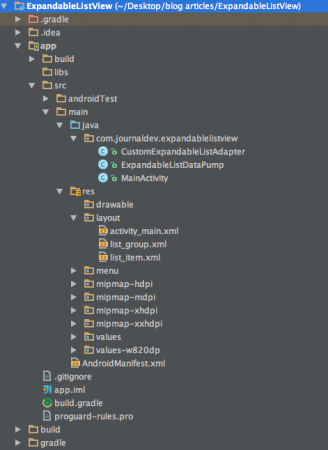欢迎学习Android ExpanableListView示例教程。在本教程中,我们将实现一个ExpanableListView ,用于按类别对列表数据进行分组。它是安卓ListView.]中的菜单和子菜单
Android可扩展ListView
Android ExpanableListView 是一种以垂直滚动的两级列表展示项目的视图。与ListView不同的是,它允许两个级别,即** 组** ,可以通过触摸查看及其各自的** 子** 项轻松展开和折叠。Android中的** ExpanableListViewAdapter** 将数据加载到该view关联的项中。下面是该类使用的一些重要方法:
- setChildIndicator(Drawable) :用于在代表当前状态的每一项旁边显示一个指示器。如果子项是组的最后一个子项,则会设置状态
STATE_LAST - setGroupIndicator(可绘制) :在分组旁边绘制一个指示器,表示分组的状态,即展开或折叠。如果组为空,则设置状态
STATE_EMPTY。如果展开组,则设置状态STATE_EXPANDED - getGroupView() :返回列表分组表头的view
- getChildView() :返回列表子项的view
此类实现的值得注意的接口如下所示:
- ExpanableListView.OnChildClickListener :重写该参数以实现在单击展开列表中的子级时调用的回调方法
- ExpanableListView.OnGroupClickListener :重写该参数,以实现点击展开列表中的组头时调用的回调方法 *ExpandableListView.OnGroupCollapseListener :用于通知群组何时折叠
- ExpanableListView.OnGroupExpanListener :用于在组展开时通知
Android ExpandableListView项目结构
- 用ExpanableListView显示布局的 MainActivity**
- 表示列表中的随机数据并使用HashMap将子项数据映射到各自的组头的 ExpanableListDataPump**
- A CustomExpanableListAdapter** ,它为MainActivity提供来自ExpanableListDataPump类的数据/li>
Android可扩展ListView代码
Active_main.xml布局由RelativeLayout中的ExpanableListView组成,如下所示:active_main.xml
1<RelativeLayout xmlns:android="https://schemas.android.com/apk/res/android"
2 xmlns:tools="https://schemas.android.com/tools"
3 android:layout_width="match_parent"
4 android:layout_height="match_parent"
5 android:paddingLeft="@dimen/activity_horizontal_margin"
6 android:paddingRight="@dimen/activity_horizontal_margin"
7 android:paddingTop="@dimen/activity_vertical_margin"
8 android:paddingBottom="@dimen/activity_vertical_margin"
9 tools:context=".MainActivity">
10
11 <ExpandableListView
12 android:id="@+id/expandableListView"
13 android:layout_height="match_parent"
14 android:layout_width="match_parent"
15 android:indicatorLeft="?android:attr/expandableListPreferredItemIndicatorLeft"
16 android:divider="@android:color/darker_gray"
17 android:dividerHeight="0.5dp" />
18
19</RelativeLayout>
android:indeatorLeft 是Items指示器的左界。** 注意** :除非严格指定父列表的大小,否则不能对XML中ExpanableListView的** Android:Layout_Height** 属性使用WRAP_CONTENT,每个单独列表的组头布局如下:List_group.xml
1<?xml version="1.0" encoding="utf-8"?>
2
3<LinearLayout xmlns:android="https://schemas.android.com/apk/res/android"
4 android:orientation="vertical" android:layout_width="match_parent"
5 android:layout_height="match_parent">
6 <TextView
7 android:id="@+id/listTitle"
8 android:layout_width="fill_parent"
9 android:layout_height="wrap_content"
10 android:paddingLeft="?android:attr/expandableListPreferredItemPaddingLeft"
11 android:textColor="@android:color/black"
12 android:paddingTop="10dp"
13 android:paddingBottom="10dp" />
14</LinearLayout>
子项的布局行如下:List_item.xml
1<?xml version="1.0" encoding="utf-8"?>
2
3<LinearLayout xmlns:android="https://schemas.android.com/apk/res/android"
4 android:orientation="vertical" android:layout_width="match_parent"
5 android:layout_height="wrap_content">
6 <TextView
7 android:id="@+id/expandedListItem"
8 android:layout_width="fill_parent"
9 android:layout_height="wrap_content"
10 android:paddingLeft="?android:attr/expandableListPreferredChildPaddingLeft"
11 android:paddingTop="10dp"
12 android:paddingBottom="10dp" />
13</LinearLayout>
ExpanableListDataPump类定义如下:
1package com.journaldev.expandablelistview;
2
3import java.util.ArrayList;
4import java.util.HashMap;
5import java.util.List;
6
7public class ExpandableListDataPump {
8 public static HashMap<String, List<String>> getData() {
9 HashMap<String, List<String>> expandableListDetail = new HashMap<String, List<String>>();
10
11 List<String> cricket = new ArrayList<String>();
12 cricket.add("India");
13 cricket.add("Pakistan");
14 cricket.add("Australia");
15 cricket.add("England");
16 cricket.add("South Africa");
17
18 List<String> football = new ArrayList<String>();
19 football.add("Brazil");
20 football.add("Spain");
21 football.add("Germany");
22 football.add("Netherlands");
23 football.add("Italy");
24
25 List<String> basketball = new ArrayList<String>();
26 basketball.add("United States");
27 basketball.add("Spain");
28 basketball.add("Argentina");
29 basketball.add("France");
30 basketball.add("Russia");
31
32 expandableListDetail.put("CRICKET TEAMS", cricket);
33 expandableListDetail.put("FOOTBALL TEAMS", football);
34 expandableListDetail.put("BASKETBALL TEAMS", basketball);
35 return expandableListDetail;
36 }
37}
在上面的代码中,expandableListDetail对象用于使用Strings的ArrayList将组标题字符串映射到它们各自的子级。CustomExpanableListAdapter.java
1package com.journaldev.expandablelistview;
2
3import java.util.HashMap;
4import java.util.List;
5import android.content.Context;
6import android.graphics.Typeface;
7import android.view.LayoutInflater;
8import android.view.View;
9import android.view.ViewGroup;
10import android.widget.BaseExpandableListAdapter;
11import android.widget.TextView;
12
13public class CustomExpandableListAdapter extends BaseExpandableListAdapter {
14
15 private Context context;
16 private List<String> expandableListTitle;
17 private HashMap<String, List<String>> expandableListDetail;
18
19 public CustomExpandableListAdapter(Context context, List<String> expandableListTitle,
20 HashMap<String, List<String>> expandableListDetail) {
21 this.context = context;
22 this.expandableListTitle = expandableListTitle;
23 this.expandableListDetail = expandableListDetail;
24 }
25
26 @Override
27 public Object getChild(int listPosition, int expandedListPosition) {
28 return this.expandableListDetail.get(this.expandableListTitle.get(listPosition))
29 .get(expandedListPosition);
30 }
31
32 @Override
33 public long getChildId(int listPosition, int expandedListPosition) {
34 return expandedListPosition;
35 }
36
37 @Override
38 public View getChildView(int listPosition, final int expandedListPosition,
39 boolean isLastChild, View convertView, ViewGroup parent) {
40 final String expandedListText = (String) getChild(listPosition, expandedListPosition);
41 if (convertView == null) {
42 LayoutInflater layoutInflater = (LayoutInflater) this.context
43 .getSystemService(Context.LAYOUT_INFLATER_SERVICE);
44 convertView = layoutInflater.inflate(R.layout.list_item, null);
45 }
46 TextView expandedListTextView = (TextView) convertView
47 .findViewById(R.id.expandedListItem);
48 expandedListTextView.setText(expandedListText);
49 return convertView;
50 }
51
52 @Override
53 public int getChildrenCount(int listPosition) {
54 return this.expandableListDetail.get(this.expandableListTitle.get(listPosition))
55 .size();
56 }
57
58 @Override
59 public Object getGroup(int listPosition) {
60 return this.expandableListTitle.get(listPosition);
61 }
62
63 @Override
64 public int getGroupCount() {
65 return this.expandableListTitle.size();
66 }
67
68 @Override
69 public long getGroupId(int listPosition) {
70 return listPosition;
71 }
72
73 @Override
74 public View getGroupView(int listPosition, boolean isExpanded,
75 View convertView, ViewGroup parent) {
76 String listTitle = (String) getGroup(listPosition);
77 if (convertView == null) {
78 LayoutInflater layoutInflater = (LayoutInflater) this.context.
79 getSystemService(Context.LAYOUT_INFLATER_SERVICE);
80 convertView = layoutInflater.inflate(R.layout.list_group, null);
81 }
82 TextView listTitleTextView = (TextView) convertView
83 .findViewById(R.id.listTitle);
84 listTitleTextView.setTypeface(null, Typeface.BOLD);
85 listTitleTextView.setText(listTitle);
86 return convertView;
87 }
88
89 @Override
90 public boolean hasStableIds() {
91 return false;
92 }
93
94 @Override
95 public boolean isChildSelectable(int listPosition, int expandedListPosition) {
96 return true;
97 }
98}
此类扩展了BaseExpanableListAdapter ,并重写了基类中的方法以提供ExpanableListView的视图。GetView()将数据填充到具有给定索引的项的视图中。MainActivity.java
1package com.journaldev.expandablelistview;
2
3import android.support.v7.app.AppCompatActivity;
4import android.os.Bundle;
5import android.view.View;
6import android.widget.ExpandableListAdapter;
7import android.widget.ExpandableListView;
8import android.widget.Toast;
9
10import java.util.ArrayList;
11import java.util.HashMap;
12import java.util.List;
13
14public class MainActivity extends AppCompatActivity {
15
16 ExpandableListView expandableListView;
17 ExpandableListAdapter expandableListAdapter;
18 List<String> expandableListTitle;
19 HashMap<String, List<String>> expandableListDetail;
20
21 @Override
22 protected void onCreate(Bundle savedInstanceState) {
23 super.onCreate(savedInstanceState);
24 setContentView(R.layout.activity_main);
25 expandableListView = (ExpandableListView) findViewById(R.id.expandableListView);
26 expandableListDetail = ExpandableListDataPump.getData();
27 expandableListTitle = new ArrayList<String>(expandableListDetail.keySet());
28 expandableListAdapter = new CustomExpandableListAdapter(this, expandableListTitle, expandableListDetail);
29 expandableListView.setAdapter(expandableListAdapter);
30 expandableListView.setOnGroupExpandListener(new ExpandableListView.OnGroupExpandListener() {
31
32 @Override
33 public void onGroupExpand(int groupPosition) {
34 Toast.makeText(getApplicationContext(),
35 expandableListTitle.get(groupPosition) + " List Expanded.",
36 Toast.LENGTH_SHORT).show();
37 }
38 });
39
40 expandableListView.setOnGroupCollapseListener(new ExpandableListView.OnGroupCollapseListener() {
41
42 @Override
43 public void onGroupCollapse(int groupPosition) {
44 Toast.makeText(getApplicationContext(),
45 expandableListTitle.get(groupPosition) + " List Collapsed.",
46 Toast.LENGTH_SHORT).show();
47
48 }
49 });
50
51 expandableListView.setOnChildClickListener(new ExpandableListView.OnChildClickListener() {
52 @Override
53 public boolean onChildClick(ExpandableListView parent, View v,
54 int groupPosition, int childPosition, long id) {
55 Toast.makeText(
56 getApplicationContext(),
57 expandableListTitle.get(groupPosition)
58 + " -> "
59 + expandableListDetail.get(
60 expandableListTitle.get(groupPosition)).get(
61 childPosition), Toast.LENGTH_SHORT
62 ).show();
63 return false;
64 }
65 });
66 }
67
68}
在上面的代码中,我们实现了前面讨论过的所有接口。为简单起见,我们将在每次单击时仅显示带有项目名称或组状态的Toast。但是可以很容易地对它们进行修改,以执行任何其他操作。下面是我们的应用程序,带有Android可扩展列表视图。 备注 :ExpanableListView默认可滚动。这结束了Android ExpanableListView教程。您可以通过下面的链接下载最终的** Android ExpanableListView项目** 。
备注 :ExpanableListView默认可滚动。这结束了Android ExpanableListView教程。您可以通过下面的链接下载最终的** Android ExpanableListView项目** 。
